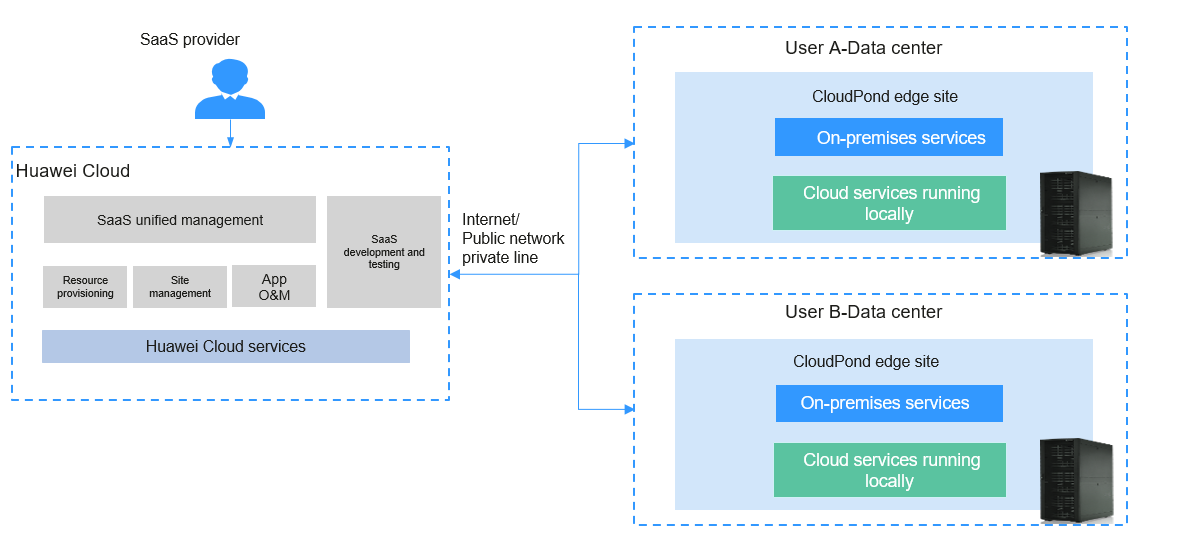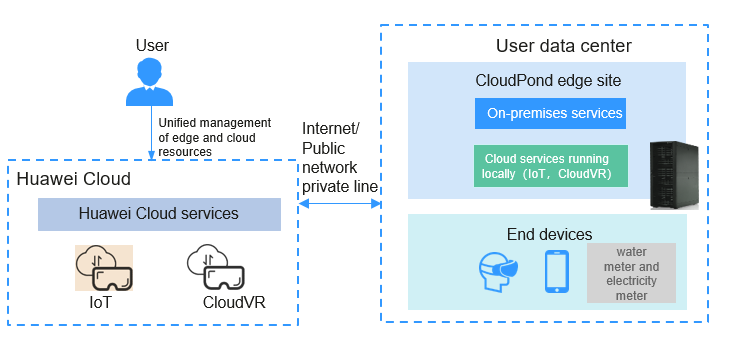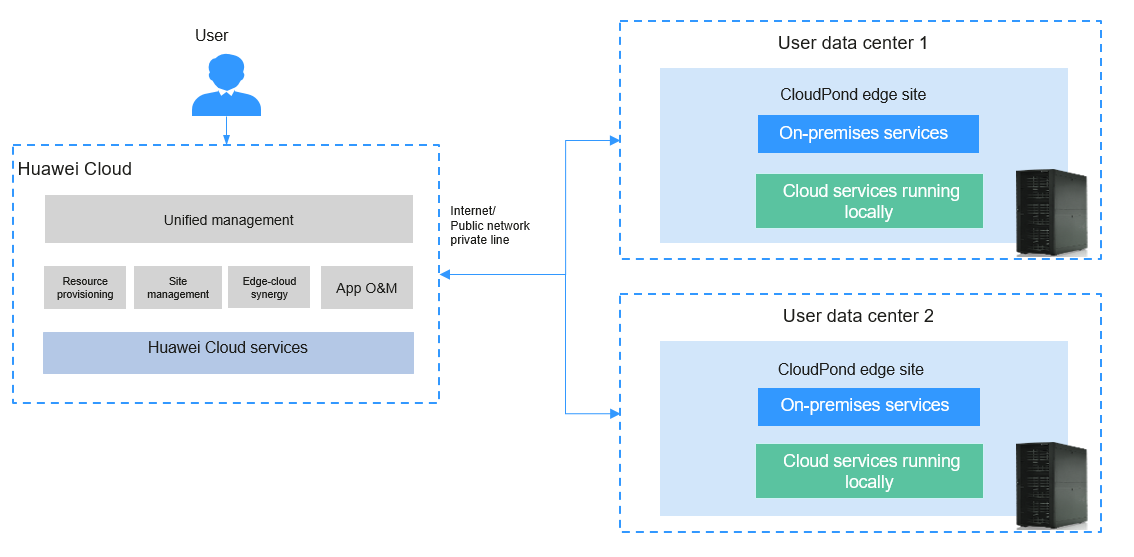Application Scenarios
Low Network Latency
Requirements
Innovative services such as VR, industrial control systems, and IoT, and high-performance computing (HPC) scenarios like electronic design automation (EDA) and gene sequencing have high requirements on network latency. However, centralized cloud computing is generally far away from on-premises devices and cannot meet the requirements for network latency.
To address these issues, enterprises need a new infrastructure that can:
- Provide cloud services locally and consistent experience as the public cloud.
- Allow on-premises devices to access cloud resources over a private network at ultra-low latency.
- Free them from complex O&M to minimize the manpower and cost.
Solution
Deploy an edge site in your on-premises data center so that you can run cloud services locally and develop innovative services at ultra-low latency. See Figure 1.
Highlights
- In addition to core cloud services, CloudPond supports a number of additional cloud services to meet your requirements for business innovation.
- Your data is processed and stored locally and can be transmitted to other local devices or applications over your on-premises network.
- Huawei Cloud provides managed infrastructure O&M, enabling you to focus on your own services and innovation.

"Managed infrastructure O&M" means that Huawei Cloud is responsible for CloudPond O&M.
Local Data Processing and Storage
Requirements
The public cloud provides scalable cloud resources. However, due to restrictions of policies and regulations, data security, service scenarios, and architecture reconstruction, many applications cannot be migrated to the public cloud.
A new infrastructure that has the following features is required:
- It is deployed locally, and the core service data is stored locally.
- It is standardized and can be seamlessly upgraded, batch deployed, and easily managed.
- It is compatible with the legacy IT system and supports cloud migration.
Solution
With pre-integrated racks deployed in your on-premises data center, you can store the service data locally and build a new platform for workloads that cannot be migrated to the cloud.
Highlights
- You can run cloud services and store your data locally.
- Standard racks are delivered as an integrated unit, and cloud services can be used on demand.
- Your on-premises network connects to the edge site using a local gateway, allowing you to easily migrate some challenging applications to the cloud.

Enterprise Branch Management
Requirements
Large enterprises often need to set up branches for office, production, warehousing, or R&D. These branches need different applications, such as attendance, finance, logistics, and sales applications.
However, many branches face problems in application running and maintenance due to different underlying infrastructure from the headquarters and complex O&M.
Branches need an infrastructure that allows them to:
- Communicate with the headquarters and transmit the data to the headquarters or other branches more easily.
- Run standard cloud services locally and enjoy consistent experience as the headquarters.
- Free them from burdensome infrastructure O&M.
Solution
Deploy an edge site at each branch so that these branches can use the unified infrastructure as the headquarters. See Figure 3.
Highlights
- The headquarters' IT team manages cloud resources for branches. The IT team at each branch only needs to operate and maintain the local equipment room. Huawei Cloud is responsible for the O&M of the infrastructure and cloud services.
- Branches use the same cloud services as the headquarters and can have consistent user experience.
- With edge-cloud synergy and private network communications, the data can be quickly transmitted between the headquarters and branches.
SaaS Application Distribution
Requirements
SaaS applications are favored by increasingly more government agencies and enterprises due to their advantages such as rich functions and on-demand use. However, the data generated by SaaS applications is stored on the cloud by default, and all application functions depend on the Internet bandwidth, resulting in poor user experience. In addition, deployment solutions provided by some SaaS application vendors are often complex.
To address these issues, a new infrastructure is required to:
- Provide the same cloud services as those on the cloud, so that SaaS applications can be quickly deployed in multiple regions after being tested on the cloud.
- Provide a cross-region communication mechanism to enable SaaS applications to be easily managed and upgraded.
- Minimize the manpower on infrastructure O&M.
Solution
Deploy edge sites in on-premises data centers to enable SaaS software vendors to distribute their applications across regions.
Highlights
- The edge uses the same cloud services as the cloud, including their functions and performance indicators. SaaS application providers can directly deploy SaaS applications at the edge after the applications are tested on the cloud.
- With edge-cloud synergy and private network communication, you can run SaaS applications that are deployed in multiple regions on the cloud for unified management while storing your service data on premises.
- The infrastructure O&M is undertaken by Huawei Cloud, and the infrastructure can be scaled seamlessly.

"Managed infrastructure O&M" means that Huawei Cloud is responsible for CloudPond O&M.

Feedback
Was this page helpful?
Provide feedbackThank you very much for your feedback. We will continue working to improve the documentation.See the reply and handling status in My Cloud VOC.
For any further questions, feel free to contact us through the chatbot.
Chatbot







